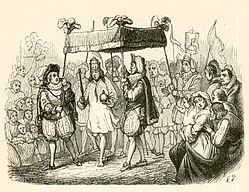The Emperor's New Clothes (fairy tale)
| "The Emperor's New Clothes" | |
|---|---|

Illustration by Vilhelm Pedersen, Andersen's first illustrator
|
|
| Author | Hans Christian Andersen |
| Original title | "Kejserens nye Klæder" |
| Country | Denmark |
| Language | Danish |
| Genre(s) | Literary folktale |
| Published in | Fairy Tales Told for Children. First Collection. Third Booklet. 1837. (Eventyr, fortalte for Børn. Første Samling. Tredie Hefte. 1837.) |
| Publication type | Fairy tale collection |
| Publisher | C.A. Reitzel |
| Publication date | 7 April 1837 |
| Preceded by | "The Little Mermaid" |
| Followed by | "Only a Fiddler" |
"The Emperor's New Clothes" (Danish: Kejserens nye Klæder) is a short tale written by Danish author Hans Christian Andersen, about two weavers who promise an emperor a new suit of clothes that they say is invisible to those who are unfit for their positions, stupid, or incompetent. When the emperor parades before his subjects in his new clothes, no one dares to say that they don't see any suit of clothes on him for fear that they will be seen as "unfit for their positions, stupid, or incompetent". Finally, a child cries out, "But he isn't wearing anything at all!" The tale has been translated into over 100 languages.
"The Emperor’s New Clothes" was first published with "The Little Mermaid" in Copenhagen, by C. A. Reitzel, on 7 April 1837, as the third and final installment of Andersen's Fairy Tales Told for Children. The tale has been adapted to various media, and the story's title, the phrase "The Emperor has no clothes", and variations thereof have been adopted for use in numerous and as an idiom.
A vain emperor who cares about nothing except wearing and displaying clothes hires two weavers who promise him the finest, best suit of clothes from a fabric invisible to anyone who is either unfit for his position or "hopelessly stupid". The emperor's ministers cannot see the clothes themselves, but pretend that they can for fear of appearing unfit for their positions, and the emperor does the same. Finally, the weavers report that the suit is finished, they mime dressing him, and the emperor marches in procession before his subjects. The townsfolk play along with the pretense, not wanting to appear unfit for their positions or stupid. Then, a child in the crowd, too young to understand the desirability of keeping up the pretense, blurts out that the emperor is wearing nothing at all, and the cry is taken up by others. The emperor suspects the assertion is true but continues the procession.
Andersen's tale is based on a 1335 story from the Libro de los ejemplos (or El Conde Lucanor), a medieval Spanish collection of fifty-one cautionary tales with various sources such as Aesop and other classical writers and Persian folktales, by Juan Manuel, Prince of Villena (1282–1348). Andersen did not know the Spanish original but read the tale in a German translation, titled "So ist der Lauf der Welt". In the source tale, a king is hoodwinked by weavers who claim to make a suit of clothes invisible to any man not the son of his presumed father; whereas Andersen altered the source tale to direct the focus on courtly pride and intellectual vanity rather than adulterous paternity.
...
Wikipedia
